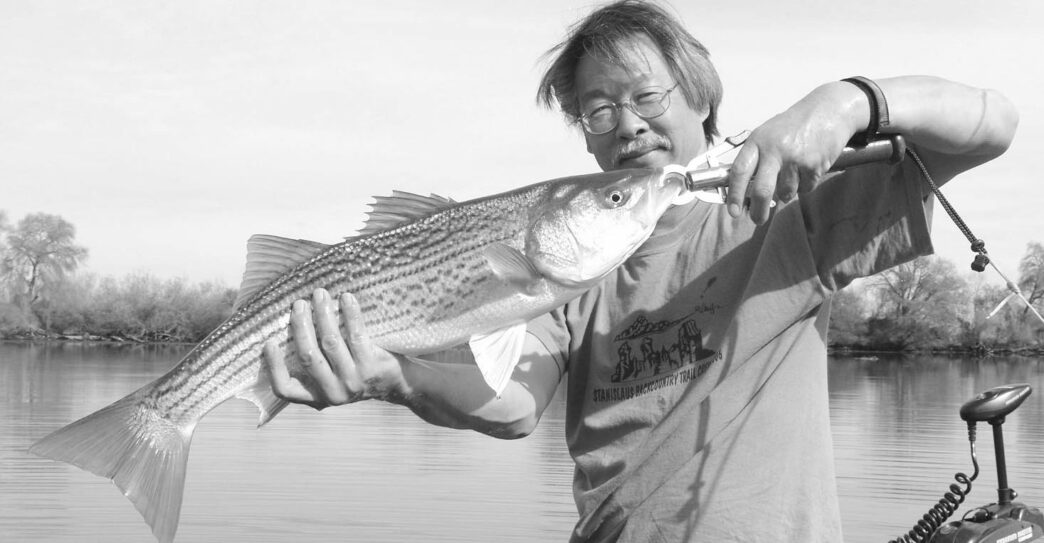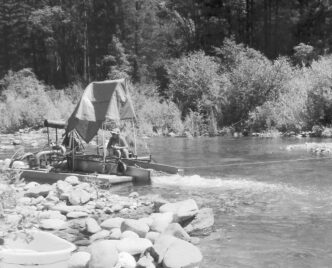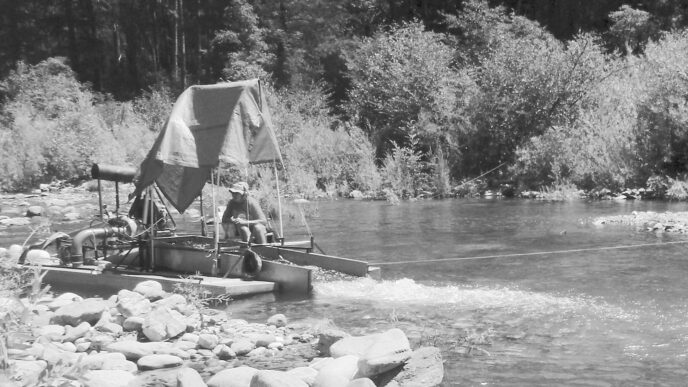Striped bass are aquatic vacuum cleaners. They eat nearly anything that swims. Juveniles eat microscopic invertebrates by the ton. Adult striped bass need more calories, so they seek bigger meals from a wide variety of forage fish. In the Sacramento–San Joaquin Delta, striped bass feed on minnows such as threadfin shad, Mississippi silversides, and others. They even feed on their own juveniles. Stripers also feed on small fish such as the tidewater goby, Delta smelt, longfin smelt, and young steelhead chinook and coho salmon — all listed species under the state or federal Endangered Species Act (ESA).
And therein is the problem for stripers, whose numbers have fluctuated wildly since 132 of them were first transported by rail from a river in New Jersey and planted in waters near Martinez in 1879. Stripers are very aggressive nocturnal feeders — some anglers have seen stripers eat baby ducks — but 90 percent of the adult striper diet consists of minnows. Stripers have always been popular with anglers, and the California Department of Fish and Game and its policy-making parent, the California Fish and Game Commission, have had a longstanding policy of promoting the species in the Delta.
In 1996, the Fish and Game Commission adopted a policy “to increase the number of striped bass to 3 million adults while ensuring that actions to increase striped bass abundance are consistent with the long term mission and public trust responsibilities, including those related to threatened and endangered species.” That policy has never been changed.
In the mid to late 1980s, the DFG planted some one million hatchery-raised stripers in the Delta annually, but halted the practice in the early 2000s because of concern over overpopulation and its impact on threatened and endangered species, whose numbers were plummeting.
The decline in endangered species has triggered a contentious and noisy debate over its causes, which could include the pumping of too much water from the Delta, loss of spawning habitat, water pollution — and predation by stripers. In fact, no one can agree on the cause of the decline because of the lack of monitoring and research on the topic.
This lack of agreement has played a role in delays in the adoption by policymakers of a comprehensive, long-range plan for the Delta. The latest attempt is embodied in the draft of the Bay Delta Conservation Plan, which for the first time has placed protecting endangered fish on equal footing with providing water for agriculture and urban development. For a number of years, water managers placed a higher priority on providing water for agriculture and development than on sustaining a fishery.
One influential group decided not to wait for water-policy officials to agree on the new Delta plan. The Coalition for a Sustainable Delta, which is supported by well-funded Kern County farming and development interests, sued the DFG, arguing that striped bass are major contributors to the decline of endangered species in the Delta.
Last fall, the DFG apparently agreed and decided to reduce the striper population to protect the threatened and endangered species. The agency is enlisting the help of anglers by allowing them to catch and keep more stripers.
As part of the lawsuit settlement agreement, the DFG has proposed increasing the daily bag limit on Delta stripers from 2 to 6 fish, with 12 in possession. The proposed size limit has been reduced to 12 inches. In Clifton Court Forebay, which is located near the Delta pumps, the daily bag limit is 20 fish of any size, with a possession limit of 40. Anglers must describe their catches to the DFG on a free report card. The new regulations also would allow the harvesting of striped bass in the Carmel, Pajaro, and Salinas Rivers when the fisheries there would otherwise be closed.
“Why these changes?” asked the DFG in a briefing recently at a well-attended hearing in Rio Vista. “It balances the striped bass fishery with the need to preserve listed species. Data indicate that the existing striped bass fishery in the Delta will not collapse if these proposed changes are implemented.”
In the presentation at the hearing, the DFG said that its research and monitoring show that the numbers of fish in the winter and spring runs of chinook salmon are “extremely low,” which had resulted in their Endangered Species Act listing in the 1980s. Delta smelt were listed in 1993 and “have declined further since the listing.” Longfin smelt were listed in 2010.
Monitoring by the DFG and other agencies shows that the production of juvenile striped bass has declined, too, but that the number of adult fish “remains high due to management actions and the species’ innate resilience.” Officials estimate the population is in the millions, and data show that between one hundred thousand and two hundred thousand are caught annually by anglers fishing from private or party boats or from the shoreline.
The Fish and Game Commission will hold a hearing and consider adopting the proposed changes in regulations at its February 1–2, 2012, meeting in the auditorium of the Resource Building, 1416 Ninth Street, in Sacramento. If the proposal is approved, the DFG will analyze its impact on the environment and hold three more public hearings before final approval, which would occur by the end of 2012. If approval fails, the proposal dies, and striper bag limits will remain unchanged.
This proposed change in the regulations has set off a firestorm of controversy in the angling world. Talk shows have been buzzing. Outdoor columnists have been writing blazing rants against the policy. Some conservation groups have joined the fray.
“The Department has issued draft regulations that will eradicate the striped bass. This proposal stinks rotten,” said an action alert by the California Sportfishing Protection Alliance, California Striped Bass Association, and Water 4 Fish, which represents some 100 businesses, fishing guides, and conservation groups. “It is a brazen move to undo the rights of the citizens of California to use and enjoy the water and aquatic resources of the state. We need to fight back with every mechanism at our disposal.”
They are fighting back through a huge lobbying campaign. The group says its supporters have sent nearly sixty thousand e-mails to governmental agencies and have collected one hundred and twenty thousand signatures opposing the change in regulations. The group plans to present the petition at the Fish and Game Commission meeting and to pack the hearing with its supporters. No groups have surfaced to support the regulation changes.
The DFG’s proposed change in the angling regulations is just the latest of a series of recent recommendations for reducing the number of stripers in the Delta. Last year, the National Marine Fisheries Service asked the Fish and Game Commission to remove all restrictions on fishing for stripers in order to protect threatened and endangered species.
The proposal was not adopted, but a comment letter from Dr. Peter Moyle, well-known University of California– Davis fisheries biology professor who has researched striper behavior in Suisun Marsh, provided a glimpse into the relationship between striped bass and endangered species.
“Reducing the striped bass population may or may not have a desirable effect,” said Moyle, referring to the policy’s goal of protecting threatened and endangered species. “The contribution of striped bass to fish declines is not certain. The agencies are inadvertently playing roulette with basic ecosystem processes that can change in unexpected ways in response to reducing bass numbers.”
Moyle indicated that his research shows the following:
- “Delta smelt were a minor item in striped bass diets when they were highly abundant in the early 1960s, as well as in recent years at record low abundance.”
- “Striped bass are unlikely to be a major predator of delta smelt because smelt are semi-transparent [hard to see in turbid waters] and do not school, unlike more favored prey such as threadfin shad, juvenile striped bass and Mississippi silversides.”
- “Striped bass will feed heavily on juvenile salmon and steelhead in the rivers, which is well documented. However, most salmon eaten are likely to be naïve fish from hatcheries; high predation on them has little bearing on the degree of predation encountered by more wary juveniles from natural spawning.”
- “Much of the predation of juvenile salmon seems to take place in conjunction with artificial structures and poor release practices. These include release of fish from hatcheries. Opportunistic predators, such as striped bass, are extremely quick to cue on predictable events, such as regularly timed releases of smolts at a single location. Changing the simple-minded protocols associated with fish releases may be a wiser approach for reducing such predation.”
- “Mississippi silversides are important in the diets of one to three-year-old striped bass, so bass predation could be regulating the silver-side population. If true, then relieving silversides from striped bass predation pressure is likely to increase their numbers, which could have a negative effect on delta smelt through predation on eggs and larvae.”
- “There is a tendency to dismiss other predators as being insignificant. In fact, there are a multitude of other predators on juvenile salmon in the system, from birds (e.g. mergansers, cormorants, terns) to other fish, native and non-native, including juvenile steelhead. The most abundant fish predator in the Delta today is probably the largemouth bass. If a control program [for striped bass] can be justified, then it is likely one should also be instituted for largemouth bass, as well as for spotted bass, channel catfish and other non-native predatory fish.”
- “Overall, the key to restoring populations of desirable species . . . is to return the delta to being a more variable, estuarine environment. This is likely to happen naturally with sea level rises and levee collapses, but the population of delta smelt and similar fishes may not be able to last that long. We stress that attempting to reduce striped bass and other predator populations is unlikely to make a difference in saving endangered fishes and will serve only to distract attention from some of the real problems.”
- “The take home message from all this is that reducing the striped bass population may or may not have the desired effect. In our opinion, it is most likely to have a negative effect.”
Action by state and federal regulators could be business as usual for striper angling — or it could be the end of the line for striped bass in the Delta. No one is quite sure how the issue of the striper fishing regulations will be resolved, but the issue of the future of stripers will surely remain contentious given the factors that harm our game fish populations will only grow worse over time.
For the DFG’s information on the status and history of stripers in the state and a PowerPoint slide show, see http://dfg.ca.gov/delta/stripedbass. For the Fish and Game Commission meeting schedule and agendas, see meetings. For a live video feed of the Fish and Game Commission meeting, see http://www.cal-span.org. For information from the fishing groups opposing the regulations and their petition, see ter4fish.org.












